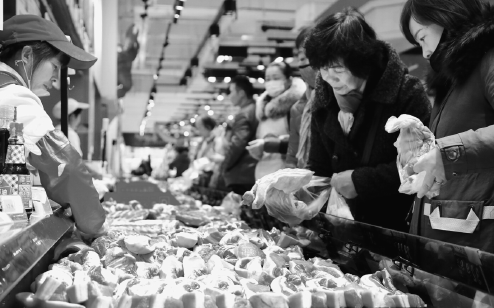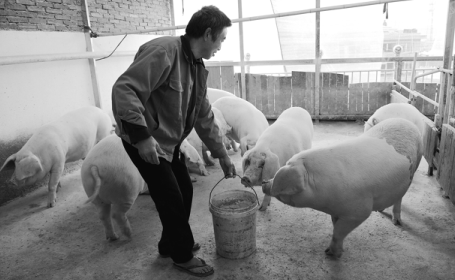Pork in 2020 holidays expected to be abundant
By ZHU WENQIAN (China Daily) Updated: 2020-01-01 00:00Pork, a staple in China, will continue to be one of the major delicacies on the dining tables of Chinese consumers for the New Year 2020 and the upcoming Spring Festival.
Increasing supplies have helped to trim pork prices and fulfill the high demand during the booming festive period.
China has been the world's largest consumer of pork, accounting for more than 60 percent of the nation's meat consumption.
The year 2019 was the year of the pig in the Chinese zodiac. Yet, the year witnessed a dramatic price hike in pork. An outbreak of African swine fever has resulted in a shortage of more than 10 million metric tons of pork or at least 20 percent of China's total pork output in 2019.
Industry experts said it would take at least six months for a full recovery in pig production capacity and the breeding of new pigs.
On Dec 27, the average wholesale price of pork nationwide was 42.89 yuan ($6.14) per kilogram, down 18.15 percent from the average price on Nov 1, but still about 140 percent higher from the year ago level, the Ministry of Agriculture said.
According to the Ministry of Commerce, starting December, the government began introducing 140,000 tons of reserved frozen pork in three batches into the market, to increase supplies and stabilize prices during the festive period.
"The central government has significantly increased its supply of frozen pork in the market, and the support is expected to last until Spring Festival. This time, the volume was much higher than the volume of reserved frozen pork that exited the warehouses in September," said Zhu Zengyong, a pork analyst at the Chinese Academy of Agricultural Sciences.
Ahead of the National Day holiday in 2019, the government released a total of 30,000 tons of reserved frozen pork into the market on Sept 19, 26 and 29 to expand supplies and curb rising pork prices.
"Some local governments have also started to put their own reserved frozen pork in the market. This indicates a positive signal that meat supply, including pork, will be abundant during the festive period, and prices are foreseen to remain stable," Zhu said.
"In the first half of 2020, pork prices are expected to remain at a high level. In the second half of the year, pork prices will return to a reasonable level with the recovery of production, and it will enter a new round of the price cycle," he explained.
He added that in the next few years, the safety level of pig breeding, production and management would get promoted. The meat consumption structure of Chinese will be optimized, and the consumption proportion of poultry is likely to increase significantly.
With a diversification of tastes and the increasing income of Chinese consumers, their consumption volume of pork nationwide dropped to 54.89 million tons in 2019 from 57.19 million tons in 2014.
But the pork consumed in China still makes up half of the global consumption volume.
Except for some inland areas where people eat more beef and mutton in those areas because of religious beliefs and local customs, people who live in most other provinces eat pork as their major source of meat.
When Chinese prepare special goods for their most important holiday in Spring Festival, many of the people, especially those who live in southern China, like to buy marinated pork, sausages and cured meat, or cook it themselves.
For residents living in northern China, they have a custom of cooking dumplings or steamed stuffed buns for the festival, and pork acts as a necessary ingredient. The Spring Festival falls on Jan 25 in 2020.
Daoxiangcun, a time-honored food brand that has been a favorite of Beijing residents, sells various freshly made seasonal delicacies and pastries. A consumer surnamed Zhang intended to buy a small portion of sweet and sour spare ribs in cold dishes at a Daoxiangcun store. But it costs 70 yuan per 500g. The consumer said it was still too expensive, and she would not buy much at this time.
In comparison, beef is the favorite meat of Americans, consumed either through burgers or steaks. Beef accounts for 60 percent of the total meat consumption in the United States and pork's share is less than 40 percent.
The China unit of US supermarket chain Walmart said it has made full preparations to ensure the supply of fresh and safe pork to meet the strong demand from Chinese consumers during the New Year and the Spring Festival holiday period.
"We have become a strategic partner with a few major domestic pork retailers such as Henan Shuanghui Investment and Development Co and Jinluo Group to ensure the stable supply of pork in China. Besides, we have increased the portion of imported pork to China, utilizing our global supply resources," said the China unit of the world's largest chain retailer.
In May, Walmart sent a team to visit pig-breeding farms in Denmark. Since then, it started to import a large volume of Denmark pork to its supermarkets in China, in addition to introducing more kinds of imported poultry, mutton and beef.
In November, Walmart launched a hotpot promotional event at its stores in China, and the event has helped to drive nearly 40 percent of sales growth of its hotpot-related food ingredients.
Sales of poultry surged almost 50 percent year-on-year, and sales of pork and beef netted double-digit growth year-on-year, the company said. The company did not disclose specific numbers though.
Major domestic pork breeders have been increasing their production of pork. The government will further increase the financial support of related projects from the central budget, the National Development and Reform Commission said in late December.
Producers should continue to increase the production volume of other kinds of meat, and the substitution of pork by poultry and seafood has jumped sharply. In addition, China will further boost its import of pork and other meats like beef to increase the supply during the festive period, the NDRC said.
China imported 1.58 million tons of pork from global markets in the first 10 months of 2019, mainly from European countries such as Spain, Germany, the Netherlands, Denmark, France, the United Kingdom, along with South America and the United States, data from the Ministry of Commerce showed.
The NDRC said the central government will also urge local governments to launch relevant linkage mechanisms based on price changes, and distribute enough subsidies to impoverished residents.


- 'Cooperation is complementary'
- Worldwide manhunt nets 50th fugitive
- China-Japan meet seeks cooperation
- Agency ensuring natural gas supply
- Global manhunt sees China catch its 50th fugitive
- Call for 'Red Boat Spirit' a noble goal, official says
- China 'open to world' of foreign talent
- Free trade studies agreed on as Li meets with Canadian PM Trudeau
- Emojis on austerity rules from top anti-graft authority go viral
- Xi: All aboard internet express











